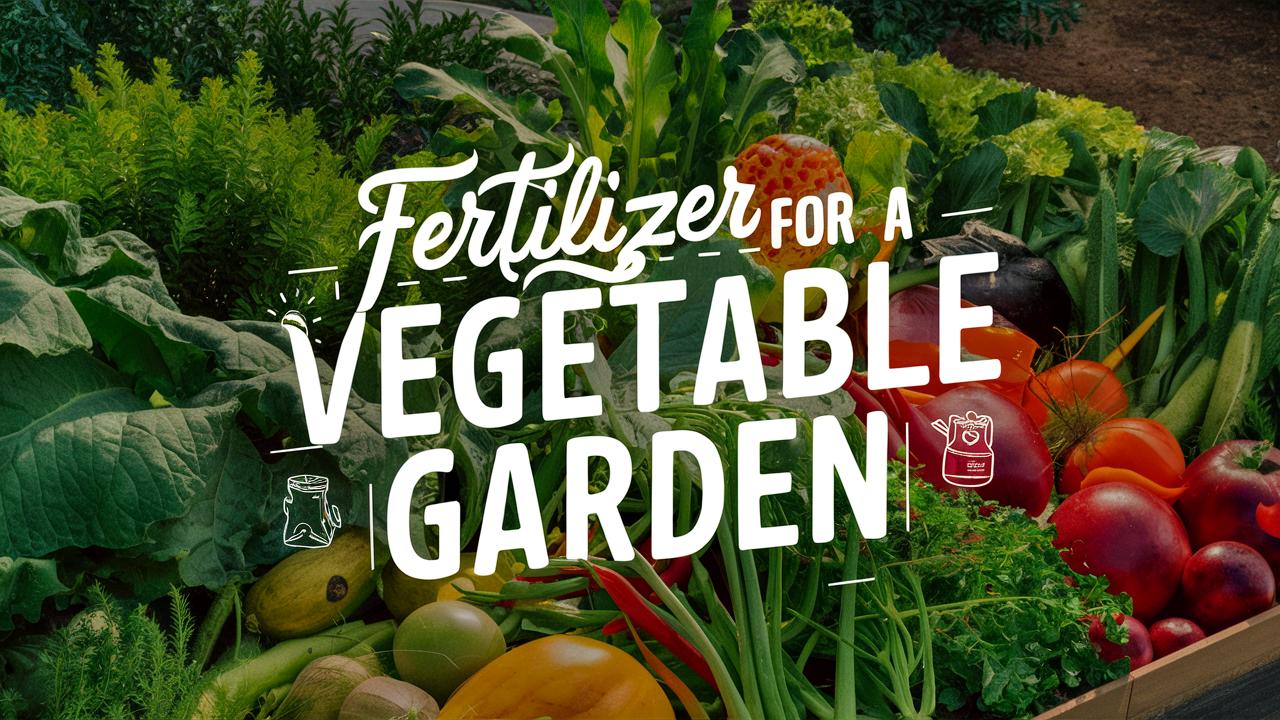In this guide, we will take you through the essential elements to consider when selecting a fertilizer, the different types available, and how to tailor your choice to meet the specific needs of your soil and plants.
Fertilizer For A Vegetable Garden
| Image | Name | Rating | Shop |
|---|---|---|---|
 | VeggieFeED |  | |
 | 10-10-10 Fertilizer |  | |
 | Miracle-Gro Shake ‘N Feed Plant Food. |  |
VeggieFeED
Jack’s Classic 12-15-30 Veggie Feed Water-Soluble Fertilizer is a convenient and effective option for vegetable gardens. Its water-soluble powder can be easily mixed with water to create multiple gallons of liquid fertilizer, making it a cost-effective choice.
This product is suitable for a variety of garden vegetables and provides the necessary micronutrients for optimal growth and health. The included measuring spoon makes it easy to get the right amount of fertilizer to your plants. The 12-15-30 analysis ensures that your plants receive balanced nutrients from roots to green foliage, which promotes vigorous growth and abundant flowering and fruit set.
10-10-10 Fertilizer
Folks looking for a reliable all-around fertilizer option might want to consider giving GreenView Multi-Purpose Fertilizer a shot. As its name suggests, this product is designed to provide a balanced combination of nitrogen (N), phosphorus (P), and potassium (K) – a formula often abbreviated as 10-10-10 NPK.
This versatile fertilizer can be used on a wide range of plants, including veggies, flowers, trees, shrubs, and ornamentals. It’s especially handy for gardeners who have diverse gardens or need to fertilize multiple types of plants at once. Just keep in mind that you’ll want to check the label for specific guidance on application rates based on your individual plant needs.
Miracle-Gro Shake ‘N Feed Plant Food.
Miracle-Gro Shake ‘N Feed Tomato, Fruit & Vegetable Plant Food is a great option for those looking to provide nutrients to their vegetable garden. This product feeds plants for up to 3 months, making it a convenient choice for gardeners who may not have time to fertilize regularly.
This plant food contains calcium, which helps form stronger walls and produce better quality fruits and vegetables. It can be used with both in-ground and container plants, and is especially suitable for vegetable, fruit, and tomato plants. Reapply every 3 months for long-lasting results and regular watering to keep your garden looking its best.
Organic Vegetable Fertilizer
This fertilizer, Dr. Earth Organic 5 Tomato, Vegetable & Herb Fertilizer Poly Bag, is a good option for those looking to feed their vegetable garden with organic and natural ingredients. The product boasts an impressive list of features including optimum levels of primary plant nutrients, no GMOs, chicken manure or sewage sludge, and the presence of beneficial soil microbes.
The addition of pro-biotic strains of beneficial soil microbes and mycorrhizae in this product is a significant selling point for gardeners looking to improve the health and fertility of their soil. With a long-lasting formula that feeds plants for several months, you can be confident that your vegetables will receive a steady supply of nutrients throughout the growing season. If you’re seeking a reliable and organic way to promote healthy plant growth and increase crop yields in your vegetable garden, this fertilizer is certainly worth considering.
Down to Earth Vegetable Garden Fertilizer
The Down to Earth Organic Vegetable Garden Fertilizer 4-4-4, 1lb is a solid choice for gardeners looking to provide their plants with a balanced diet of nutrients without resorting to synthetic fertilizers.
With its all-purpose formula, this fertilizer can be used throughout the growing season to support healthy growth and development in a wide range of vegetables, from springtime greens to summer tomatoes. Its broad nutrient profile also makes it suitable for herb gardens, where fragrance is as important as flavor. The balanced 4-4-4 ratio ensures that your garden gets what it needs to thrive without overloading on any single nutrient.
Tomato-tone
This product is a great option for anyone looking to fertilize their vegetable garden, especially those with tomatoes and other veggies. Espoma’s Organic Tomato-Tone fertilizer is made from natural and organic ingredients that promote healthy plant growth and fruit production.
We recommend using this fertilizer every 2 weeks throughout the growing season to get the best results. It’s easy to use – simply apply it around the drip line of your plants, water thoroughly, and enjoy a bounty of plump, healthy tomatoes and veggies. Plus, with its balanced 3-4-6 fertilizer analysis and 8% calcium content, you can trust that Tomato-Tone is helping prevent blossom end rot and promoting overall plant health.
Burpee Organic Plant Food
The Burpee Organic Tomato & Vegetable Granular Plant Food, 4 lb is a good choice for fertilizing an organic vegetable garden. This all-purpose granule is designed to provide long-lasting results and promote healthy plant growth.
What sets this product apart is its ability to release essential nutrients immediately and continuously over a period of up to three months. This means your plants will begin producing superior results from day one, giving you a high yield throughout the growing season. As an OMRI-listed fertilizer, it’s suitable for organic gardening practices.
How To Choose a Fertilizer For A Vegetable Garden
Creating a thriving vegetable garden isn’t solely about choosing the right seeds or ensuring that you water regularly. One key ingredient that can often be overlooked—yet is crucial for the health of your plants—is fertilizer. Understanding how to choose the right fertilizer for your vegetable garden can make the difference between a bountiful harvest and a disappointing yield.
Understanding Nutrient Needs
The Basics of Plant Nutrition
Before delving into the types of fertilizers, it’s important to understand what your plants need to thrive. Plants require three primary macronutrients: nitrogen (N), phosphorus (P), and potassium (K). These nutrients are commonly referred to as NPK and are essential for various biological functions.
Nitrogen (N) supports vegetative growth and is crucial for leaf development, which is why it’s especially important for leafy greens like lettuce and spinach.
Phosphorus (P) plays a vital role in root development, flowering, and fruiting. It is essential for plants that produce fruits or seeds, such as tomatoes and peppers.
Potassium (K) enhances overall plant health by improving disease resistance and facilitating water absorption. It’s particularly beneficial for root vegetables like carrots and potatoes.
Aside from these macronutrients, plants also require micronutrients like iron, magnesium, and manganese, albeit in smaller quantities. Understanding your plants’ specific nutrient needs can help you choose a fertilizer that supports their growth effectively.
Assessing Your Soil
Soil health is the foundation of a successful vegetable garden. Before selecting a fertilizer, it’s crucial to analyze your soil’s current nutrient levels and pH. Consider getting a soil test kit, either commercially or through local agricultural extensions, which will inform you of the nutrient content of your soil, as well as its acidity or alkalinity.
A soil report typically includes recommendations for nutrient amendments, making it easier to tailor your fertilizer choice. For example, if your soil is deficient in nitrogen but rich in phosphorus and potassium, you can opt for a fertilizer that primarily addresses the nitrogen gap.
Selecting the Right Type of Fertilizer
Organic vs. Synthetic Fertilizers
When it comes to choosing fertilizer, one of the first decisions you’ll need to make is whether to use organic or synthetic options. Both have their pros and cons.
Organic Fertilizers are derived from natural sources such as compost, animal manure, and bone meal. They release nutrients slowly, improving soil structure and supporting beneficial microorganisms. This type is ideal for gardeners who prioritize sustainability and wish to minimize chemical exposure. However, organic fertilizers may require more frequent applications and can be less concentrated, meaning you might need to apply more product.
Synthetic Fertilizers are manufactured using chemical processes and deliver nutrients quickly, providing an immediate boost for plants. They are often more straightforward to apply and can be more cost-effective. However, there are potential downsides to synthetic fertilizers, such as the risk of nutrient runoff, which can damage local ecosystems and waterways. Overuse can also lead to soil degradation and a decline in microbial health.
For most vegetable gardens, a balanced approach that incorporates both organic and synthetic fertilizers can be effective, providing immediate benefits while also fostering long-term soil health.
Granular vs. Liquid Fertilizers
Another important distinction to make is between granular and liquid fertilizers.
Granular Fertilizers are slow-release formulas that feed plants over a longer period. They are suitable for broad applications and require less frequent applications. They can be mixed into the soil at planting time or sprinkled around established plants.
Liquid Fertilizers, on the other hand, are applied to foliage or soil to provide an immediate boost. They are ideal for quick fixes if your plants show signs of nutrient deficiency. However, they tend to require more frequent applications and careful measurement to avoid over-fertilization.
Choosing between granular and liquid fertilizers often depends on your gardening style, the specific needs of your plants, and how quickly you need to see results.
Understanding Fertilizer Labels
Decoding the NPK Ratio
When shopping for fertilizers, you’ll notice a set of three numbers on the packaging. These numbers represent the NPK ratio, indicating the percentage of nitrogen, phosphorus, and potassium present in the mix.
For example, a fertilizer labeled “10-10-10” means it contains 10% nitrogen, 10% phosphorus, and 10% potassium. Understanding these ratios can help you select a product tailored to the growing stage of your vegetables.
High-Nitrogen Fertilizers (like 20-10-10) are best for leafy crops and during early growth stages when plants focus on vegetative development.
Balanced Fertilizers (like 10-10-10) can be used for a variety of plants and support broader nutrient needs.
High-Phosphorus Fertilizers (such as 5-10-5) are excellent for promoting root development, flowering, and fruiting, making them suitable for flowering vegetables.
Supplementary Ingredients
Beyond the NPK ratios, also pay attention to any additional nutrients or supplements listed on the label. Some fertilizers include micronutrients like boron, calcium, or magnesium, which can be beneficial, especially in soils that may lack these elements.
Certain brands might also include slow-release coatings or organic matter to improve nutrient availability over time. When evaluating different products, consider any unique supplements that may cater specifically to the needs of your vegetable garden.
Timing Your Fertilizer Applications
Importance of Timing
Understanding the timing of your fertilizer applications is as crucial as the type you choose. Different stages in vegetable growth require different nutrient demands. For instance, seedlings generally need less nitrogen than established plants, while fruiting vegetables require more phosphorus and potassium once they begin to flower.
Pre-Planting Fertilization
Before planting, consider amending your garden soil with compost, well-rotted manure, or a balanced fertilizer. This pre-planting fertilization enriches the soil, providing a healthy environment for your crops to thrive.
During the Growing Season
As your plants grow, assess their nutrient needs regularly. Signs of nutrient deficiency may include yellowing leaves, stunted growth, or poor flowering. If you notice these symptoms, consider applying a liquid fertilizer to quickly alleviate deficiencies.
Another helpful practice is to fertilize during key growth stages. For example, fertilizing before flowering can boost fruit development and production.
Tailoring Fertilizer Choices to Specific Vegetables
Leafy Greens
Plants like lettuce, spinach, and kale benefit from fertilizers high in nitrogen. Look for organic options like fish emulsion or a balanced synthetic fertilizer with a higher first number, such as 20-5-10.
Root Vegetables
For crops such as carrots, beets, and potatoes, opt for fertilizers that provide a blend of nitrogen, phosphorus, and potassium without being overly rich in nitrogen during late growth stages. A ratio like 5-10-10 is good for these plants once established.
Fruit-Bearing Plants
Tomatoes, peppers, and cucumbers benefit from fertilizers that emphasize phosphorus for flowering and potassium for fruit development. Look for fertilizers with a high middle and last number, such as a 5-10-10 or 8-16-16 ratio.
Herbs
Herbs like basil, cilantro, and parsley do well with a balanced fertilizer that doesn’t overwhelm them. Casual feeding with a general-purpose organic fertilizer or compost will usually suffice.
Alternative Fertilization Methods
Composting
Composting is an excellent way to enrich your vegetable garden naturally. Homemade compost, made from kitchen scraps, yard waste, and other organic materials, provides an all-around nutrient boost while improving soil structure and biodiversity.
Organic Amendments
Other organic amendments, such as bone meal for phosphorus or greensand for potassium, can be valuable additions. These options provide specific nutrients without the synthetic chemicals found in some commercial fertilizers.
Foliar Feeding
Foliar feeding is another technique where liquid fertilizers are applied directly to plant leaves. This method allows for quicker nutrient uptake and can be a useful strategy if you’re in a pinch with nutrient deficiencies.
Best Practices for Fertilizing Your Vegetable Garden
Start Small
When fertilizing for the first time, start with smaller amounts. It’s better to under-fertilize than over-fertilize, as excess nutrients can lead to plant stress or environmental damage.
Follow Soil Test Recommendations
Always adhere to the recommendations provided by your soil test results. These tests offer a tailored guide for your specific soil conditions and are the best way to ensure you’re meeting your plants’ needs.
Monitor Progress
Keep an eye on your plants after fertilization. Regular monitoring can help you adjust your feeding strategy as necessary, ensuring your vegetables get the right nutrients at the right time.
Sustainability Considerations
If you’re environmentally conscious, consider implementing sustainable practices, such as using organic fertilizers, practicing crop rotation, and integrating cover crops to enhance soil fertility.
Conclusion
Choosing the right fertilizer for your vegetable garden is a multifaceted decision that requires consideration of various factors, including plant needs, soil conditions, and growth stages. By understanding the nutrient requirements of your plants, evaluating your soil’s health, and selecting the appropriate type and timing of fertilizer, you can cultivate a thriving garden that provides delicious and nutritious produce.









